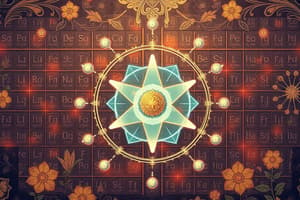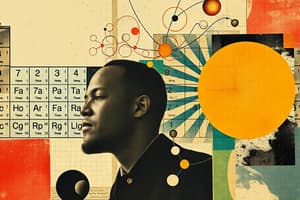Podcast
Questions and Answers
What distinguishes ionic bonds from covalent bonds?
What distinguishes ionic bonds from covalent bonds?
- Ionic bonds are formed by the transfer of electrons. (correct)
- Ionic bonds involve sharing of electrons.
- Ionic bonds are weaker than covalent bonds.
- Ionic bonds occur between nonmetals.
Which of the following correctly describes neutrons?
Which of the following correctly describes neutrons?
- Positively charged particles in the nucleus.
- Neutral particles that contribute to atomic mass. (correct)
- Negatively charged particles in the nucleus.
- Particles that orbit the nucleus in energy levels.
In which state of matter do particles have a definite shape and volume?
In which state of matter do particles have a definite shape and volume?
- Liquid
- Solid (correct)
- Gas
- Plasma
What is true about the periodic table's groups and periods?
What is true about the periodic table's groups and periods?
Which type of reaction is represented by the equation AB + CD → AD + CB?
Which type of reaction is represented by the equation AB + CD → AD + CB?
Which of the following characteristics defines acids?
Which of the following characteristics defines acids?
What best describes exothermic reactions?
What best describes exothermic reactions?
What function does stoichiometry serve in chemistry?
What function does stoichiometry serve in chemistry?
Which of the following statements is true regarding compounds?
Which of the following statements is true regarding compounds?
Which of the following best describes gases?
Which of the following best describes gases?
Flashcards are hidden until you start studying
Study Notes
Basic Concepts of Chemistry
- Matter: Anything that has mass and occupies space.
- Atoms: The basic unit of matter consisting of protons, neutrons, and electrons.
- Elements: Pure substances made of only one type of atom (e.g., hydrogen, oxygen).
- Compounds: Substances formed when two or more elements chemically combine (e.g., water, H2O).
Atomic Structure
- Nucleus: Central part of an atom containing protons and neutrons.
- Protons: Positively charged particles; number defines the element (atomic number).
- Neutrons: Neutral particles; contribute to the atomic mass.
- Electrons: Negatively charged particles; found in energy levels/shells surrounding the nucleus.
Periodic Table
- Organized by increasing atomic number.
- Groups: Vertical columns; elements have similar properties.
- Periods: Horizontal rows; properties change progressively across the table.
- Metals, Nonmetals, and Metalloids: Distinct categories based on physical and chemical properties.
Chemical Bonds
- Ionic Bonds: Formed by the transfer of electrons from one atom to another (e.g., NaCl).
- Covalent Bonds: Formed by the sharing of electrons between atoms (e.g., CO2).
- Metallic Bonds: Occur between metal atoms; electrons are shared freely.
Chemical Reactions
- Reactants: Substances that undergo chemical changes.
- Products: New substances formed from the reaction.
- Types of reactions:
- Synthesis: A + B → AB
- Decomposition: AB → A + B
- Single Replacement: A + BC → AC + B
- Double Replacement: AB + CD → AD + CB
- Combustion: Hydrocarbon + O2 → CO2 + H2O
States of Matter
- Solids: Definite shape and volume.
- Liquids: Definite volume but take the shape of the container.
- Gases: No definite shape or volume; particles are widely spaced.
- Plasma: Ionized gas with free-moving ions and electrons.
Acids and Bases
- Acids: Substances that donate protons (H+) and have a pH < 7 (e.g., HCl).
- Bases: Substances that accept protons or donate hydroxide ions (OH-) with a pH > 7 (e.g., NaOH).
- pH Scale: Measures acidity/basicity ranging from 0 (acidic) to 14 (basic) with 7 being neutral.
Thermodynamics
- Exothermic Reactions: Release energy (e.g., combustion).
- Endothermic Reactions: Absorb energy (e.g., photosynthesis).
Stoichiometry
- Study of quantitative relationships in chemical reactions.
- Mole Concept: 1 mole = 6.022 x 10^23 particles; used to convert between mass, moles, and number of particles.
Laboratory Techniques
- Titration: Method to determine concentration of a solution by reacting it with a standard solution.
- Filtration: Separation technique to remove solids from liquids or gases.
- Distillation: Separates substances based on different boiling points.
Safety in the Laboratory
- Use of personal protective equipment (PPE): gloves, goggles, lab coats.
- Understanding Material Safety Data Sheets (MSDS) for chemicals.
- Proper handling, storage, and disposal of chemical substances.
Matter and Its Composition
- Matter is anything that has mass and occupies space.
- The fundamental building block of matter is the atom, composed of protons, neutrons, and electrons.
- A pure substance made up of only one type of atom is called an element. Examples include hydrogen, oxygen, and gold.
- When two or more elements chemically combine, they form a compound. Water (H₂O) is a compound made up of hydrogen and oxygen.
Atomic Structure
- The central part of an atom is called the nucleus, containing protons and neutrons.
- Protons are positively charged particles that determine the atomic number of an element.
- Neutrons have no charge and contribute to the atom's mass number.
- Electrons are negatively charged particles that orbit the nucleus in specific energy levels or shells.
Organizing Elements: The Periodic Table
- The periodic table arranges elements based on their increasing atomic number.
- Groups are vertical columns, and elements in the same group share similar chemical properties.
- Periods are horizontal rows, and elements in the same period show gradual changes in properties across the row.
- Elements are classified as metals, nonmetals, or metalloids based on their physical and chemical properties.
Chemical Bonds
- Ionic bonds form when electrons are transferred from one atom to another, resulting in the formation of positively and negatively charged ions that attract each other. An example is sodium chloride (NaCl).
- Covalent bonds form when atoms share electrons to achieve stability. Carbon dioxide (CO₂) is a covalent compound.
- Metallic bonds occur between metal atoms, where electrons can move freely throughout the structure, contributing to the properties of malleability and conductivity.
Types of Chemical Reactions
- In a chemical reaction, reactants are transformed into products.
- Synthesis reactions combine two or more substances to form a single product (A + B → AB).
- Decomposition reactions break down a substance into two or more simpler substances (AB → A + B).
- Single replacement reactions involve the replacement of an element in a compound by another element (A + BC → AC + B).
- Double replacement reactions involve the exchange of elements between two compounds (AB + CD → AD + CB).
- Combustion reactions involve rapid reaction with oxygen, typically producing heat and light (hydrocarbon + O2 → CO₂ + H₂O).
Properties and States of Matter
- Solids have a fixed shape and volume due to the tightly packed arrangement of their particles.
- Liquids have a fixed volume but take the shape of their container because their particles are less tightly packed than solids.
- Gases have no fixed shape or volume, and their particles are widely spaced and move freely.
- Plasma is a highly ionized gas composed of free-moving ions and electrons, often found in extreme environments like stars.
Acids and Bases
- Acids are substances that donate protons (H+) when dissolved in water, resulting in a pH less than 7. Hydrochloric acid (HCl) is a strong acid.
- Bases are substances that accept protons or donate hydroxide ions (OH-) when dissolved in water, resulting in a pH greater than 7. Sodium hydroxide (NaOH) is a strong base.
- The pH scale measures the acidity or basicity of a solution, ranging from 0 (strongly acidic) to 14 (strongly basic). A pH of 7 is considered neutral.
Energy in Chemical Reactions
- Exothermic reactions release energy into the surroundings, often in the form of heat or light. Combustion is an example of an exothermic reaction.
- Endothermic reactions absorb energy from the surroundings. Photosynthesis, the process by which plants convert sunlight into energy, is an example of an endothermic reaction.
Stoichiometry: Quantifying Chemical Reactions
- Stoichiometry is the study of the quantitative relationships in chemical reactions.
- The mole concept is a crucial tool in stoichiometry, where one mole of a substance contains 6.022 x 10^23 particles (Avogadro's number). This allows for conversion between mass (grams), moles, and the number of particles in a sample.
Essential Laboratory Techniques
- Titration is a method for determining the concentration of a solution by reacting it with a solution of known concentration (standard solution).
- Filtration separates solids from liquids or gases using a porous barrier.
- Distillation separates substances with different boiling points by heating a mixture and collecting the vapors that condense into separate fractions.
Safety Considerations in the Lab
- Always wear personal protective equipment (PPE) in the lab, including gloves, goggles, and a lab coat.
- Familiarize yourself with the Material Safety Data Sheet (MSDS) for each chemical used in the lab, which provides detailed safety information.
- Handle, store, and dispose of chemicals properly to ensure a safe lab environment.
Studying That Suits You
Use AI to generate personalized quizzes and flashcards to suit your learning preferences.




